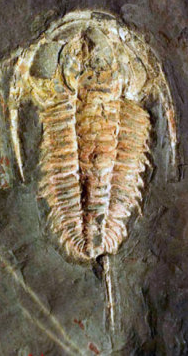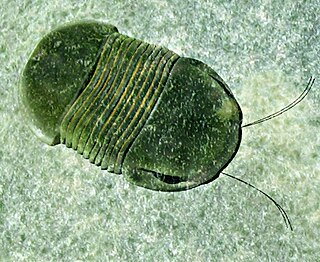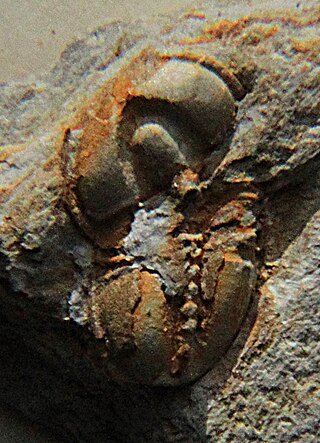Related Research Articles

Agnostida are an order of extinct arthropods which have classically been seen as a group of highly modified trilobites, though some recent research has doubted this placement. Regardless, they appear to be close relatives as part of the Artiopoda. They are present in the Lower Cambrian fossil record along with trilobites from the Redlichiida, Corynexochida, and Ptychopariida orders, and were highly diverse throughout the Cambrian. Agnostidan diversity severely declined during the Cambrian-Ordovician transition, and the last agnostidans went extinct in the Late Ordovician.
In chronostratigraphy, a stage is a succession of rock strata laid down in a single age on the geologic timescale, which usually represents millions of years of deposition. A given stage of rock and the corresponding age of time will by convention have the same name, and the same boundaries.

Trilobites are extinct marine arthropods that form the class Trilobita. Trilobites form one of the earliest known groups of arthropods. The first appearance of trilobites in the fossil record defines the base of the Atdabanian stage of the Early Cambrian period and they flourished throughout the lower Paleozoic before slipping into a long decline, when, during the Devonian, all trilobite orders except the Proetida died out. The last trilobites disappeared in the mass extinction at the end of the Permian about 251.9 million years ago. Trilobites were among the most successful of all early animals, existing in oceans for almost 270 million years, with over 22,000 species having been described.

Redlichiida is an order of trilobites, a group of extinct marine arthropods. Species assigned to the order Redlichiida are among the first trilobites to appear in the fossil record, about halfway during the Lower Cambrian. Due to the difficulty to relate sediments in different areas, there remains some discussion, but among the earliest are Fallotaspis, and Lemdadella, both belonging to this order. The first representatives of the orders Corynexochida and Ptychopariida also appear very early on and may prove to be even earlier than any redlichiid species. In terms of anatomical comparison, the earliest redlichiid species are probably ancestral to all other trilobite orders and share many primitive characters. The last redlichiid trilobites died out before the end of the Middle Cambrian.

Redlichiina is a suborder of the order Redlichiida of Trilobites. The suborder contains three superfamilies: Emuelloidea, Redlichioidea and Paradoxidoidea. These trilobites are some of the oldest trilobites known. They originated at the beginning of the Cambrian Period and disappeared at the end of the middle Cambrian.

The Emu Bay Shale is a geological formation in Emu Bay, South Australia, containing a major Konservat-Lagerstätte. It is one of two in the world containing Redlichiidan trilobites. The Emu Bay Shale is dated as Cambrian Series 2, Stage 4, correlated with the upper Botomian Stage of the Lower Cambrian.

Trimerus is an extinct genus of trilobite in the family Homalonotidae. Trimerus is one of North America's largest trilobites, reaching over 20 cm (7.9 in) in length. It had a thorax composed of 13 segments with weak trilobation, a large subtriangular head terminating in an expanded rostral plate, a two-pronged hypostome, and a triangular pygidium. It is known from all continents except for Antarctica. Its tiny compound eyes and the shovel-like anterior of the head suggests a burrowing lifestyle, and an exoskeleton marked with many small pores which, in life, probably housed hair-like sensory setae in life, allowed the trilobite to feel which portions of its body were covered with sediment.

Calymene Brongniart, 1822, is a genus of trilobites in the order Phacopida, suborder Calymenina, that are found throughout North America, North Africa, and Europe in primarily Silurian outcrops. Calymene is closely related to Flexicalymene, and both genera are frequently found enrolled. Calymene trilobites are small, typically 2 cm in length. The cephalon is the widest part of the animal and the thorax usually has 13 segments.

In anatomy, a suture is a fairly rigid joint between two or more hard elements of an organism, with or without significant overlap of the elements.

Cheirurus is a genus of phacopid trilobites that lived from the Ordovician to the Devonian. Its remains have been found in Africa, Asia, Australia, Europe, and North America. Cheirurus is the type genus of Cheiruridae.

Holochroal eyes are compound eyes with many tiny lenses. They are the oldest and most common type of trilobite eye, and found in all orders of trilobite from the Cambrian to the Permian periods. Lenses covered a curved, kidney-shaped visual surface in a hexagonal close packing system, with a single corneal membrane covering all lenses. Unlike in schizochroal eyes, adjacent lenses were in direct contact with one another. Lens shape generally depended on cuticle thickness. The lenses of trilobites with thin cuticles were thin and biconvex, whereas those with thick cuticles had thick lenses, which in extreme cases, could be thick columns with the outer surface flattened and the inner surface hemispherical. Regardless of lens thickness, however, the point at which light was focused was roughly the same distance below the lens.
The Walcott–Rust quarry, in Herkimer County, New York, is an excellent example of an obrution Lagerstätte. Unique preservation of trilobite appendages resulted from early consolidation (cementation) of the surrounding rock, followed by spar filling of the interior cavity within the appendages. The presence of so many well preserved trilobites in one location alone qualifies the beds as an exceptional trilobite site, but the beds are further distinguished as the source of the first trilobites for which appendages were definitively described.

Ptychagnostus is a member of the agnostida that lived during the Cambrian period. Ptychagnostidae generally do not exceed one centimetre in length. Their remains are rarely found in empty tubes of the polychaete worm Selkirkia. The genus probably ranged throughout the water column. It has two glabellar lobes, and three pygidial lobes.
The cephalon is the head section of an arthropod. It is a tagma, i.e., a specialized grouping of arthropod segments. The word cephalon derives from the Greek κεφαλή (kephalē), meaning "head".

The hypostome is the hard mouthpart of trilobites found on the ventral side of the cephalon (head). The hypostome can be classified into three types based on whether they are permanently attached to the rostrum or not and whether they are aligned to the anterior dorsal tip of the glabella.

Bumastus is an extinct genus of corynexochid trilobites which existed from the Early Ordovician period to the Late Silurian period. They were relatively large trilobites, reaching a length of 6 in (15 cm). They were distinctive for their highly globular, smooth-surfaced exoskeleton. They possessed well-developed, large compound eyes and were believed to have dwelled in shallow-water sediments in life.

Eodiscina is trilobite suborder. The Eodiscina first developed near the end of the Lower Cambrian period and became extinct at the end of the Middle Cambrian. Species are tiny to small, and have a thorax of two or three segments. Eodiscina includes six families classified under one superfamily, Eodiscoidea.

Indian Springs Trace Fossil Natural Area is a 40-acre privately owned site on the Indian Springs Ranch in Fremont County, Colorado. It was designated a National Natural Landmark in 1980.

Proetus is a genus of proetid trilobite found in Silurian-aged marine strata of Europe.
A trilobite is a type of extinct marine arthropod.
References
- ↑ Available Generic Names for Trilobites P.A. Jell and J.M. Adrain.